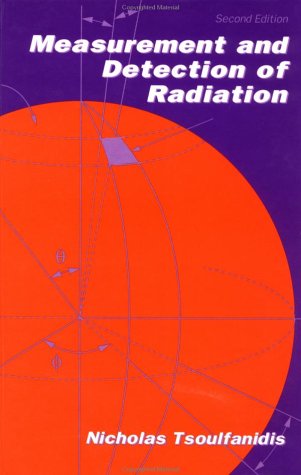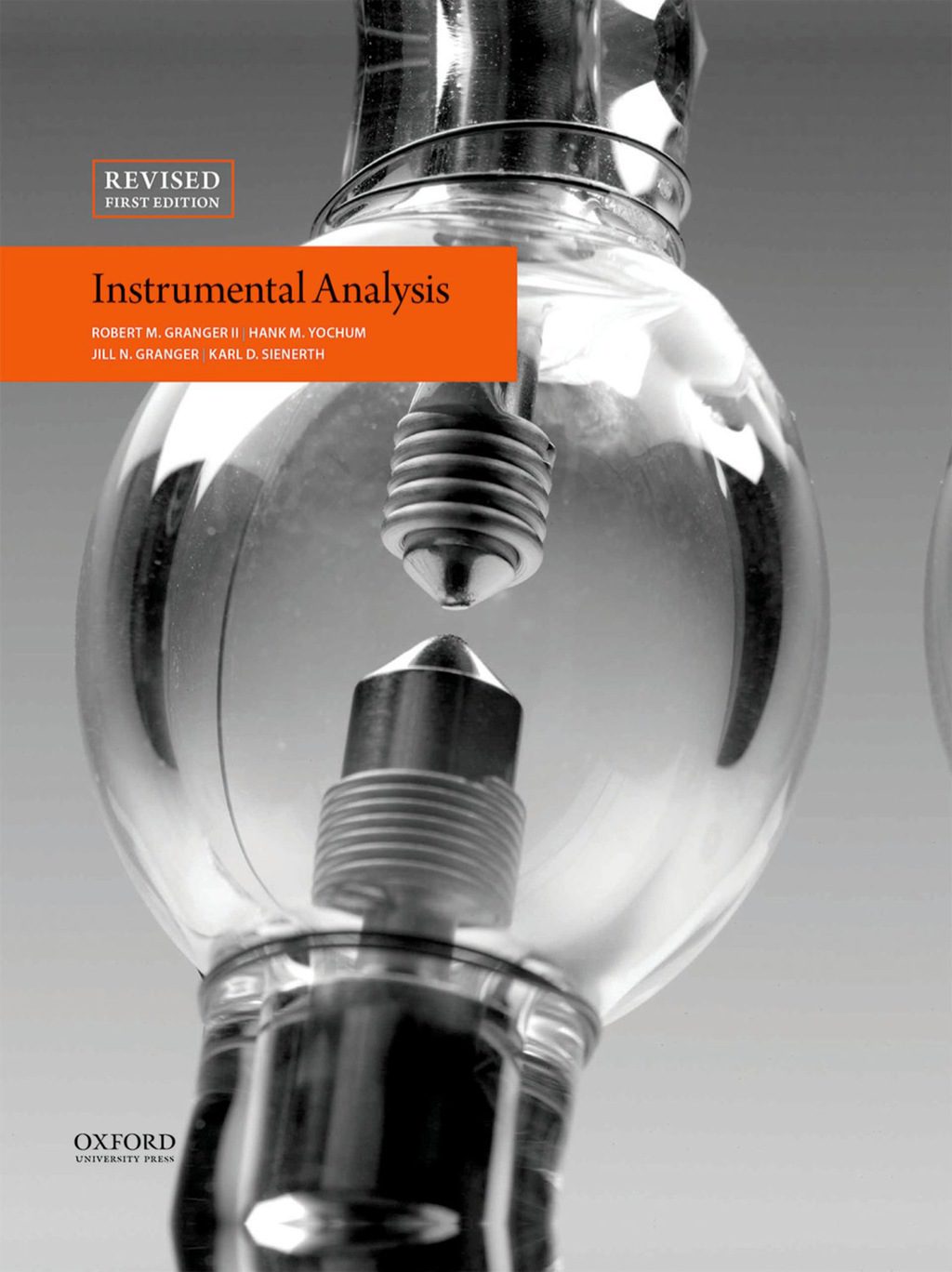Nicholas Tsoulfanidis1560323175, 9781560323174
Table of contents :
CONTENTS……Page 7
PREFACE TO THE FIRST EDITION……Page 17
PREFACE TO THE SECOND EDITION……Page 21
1.1 WHAT IS MEANT BY RADIATION?……Page 23
1.2 STATISTICAL NATURE OF RADIATION EMISSION……Page 24
1.3 THE ERRORS AND ACCURACY AND PRECISION……Page 25
1.4 TYPES OF ERRORS……Page 27
1.5.1 Introduction……Page 28
1.5.2 The Detector……Page 29
1.5.4 The High-Voltage Power Supply……Page 31
1.5.5 The Preamplifier……Page 33
1.5.6 The Amplifier……Page 36
1.5.7 The Oscilloscope……Page 38
1.5.8 The Discriminator or Single-Channel Analyzer (SCA)……Page 39
1.5.9 The Scaler……Page 42
REFERENCE……Page 43
2.2 DEFINITION OF PROBABILITY……Page 45
2.3 BASIC PROBABILITY THEOREMS……Page 47
2.4 PROBABILITY DISTRIBUTIONS AND RANDOM VARIABLES……Page 50
2.5 LOCATION INDEXES (MODE, MEDIAN, MEAN)……Page 52
2.7 COVARIANCE AND CORRELATION……Page 55
2.8 THE BINOMIAL DISTRIBUTION……Page 57
2.9 THE POISSON DISTRIBUTION……Page 59
2.10 THE NORMAL (GAUSSIAN) DISTRIBUTION……Page 61
2.10.1 The Standard Normal Distribution……Page 65
2.10.2 Importance of the Gaussian Distribution for……Page 67
2.11 THE LORENTZIAN DISTRIBUTION……Page 68
2.12 THE STANDARD, PROBABLE, AND OTHER ERRORS……Page 70
2.13 THE ARITHMETIC MEAN AND ITS STANDARD ERROR……Page 71
2.14 CONFIDENCE LIMITS……Page 74
2.15.1 Calculation of the Average and Its Standard Deviation……Page 77
2.15.2 Examples of Error Propagation-Uncorrelated Variables……Page 78
2.16 GOODNESS OF DATA-x CRITERION-REJECTION……Page 80
2.17 THE STATISTICAL ERROR OF……Page 84
2.18 THE STANDARD ERROR OF COUNTING RATES……Page 86
2.18.1 Combining Counting Rates……Page 89
2.19.1 The Background Is Constant and There Is No Time Limit for……Page 90
2.19.3 Calculation of the Counting Time Necessary to Measure a……Page 91
2.19.4 Relative Importance of Error Components……Page 92
2.20 MINIMUM DETECTABLE ACTIVITY……Page 93
2.21 COUNTER DEAD-TIME CORRECTION AND……Page 95
PROBLEMS……Page 98
REFERENCES……Page 100
3.2 ELEMENTS OF RELATIVISTIC KINEMATICS……Page 101
3.3 ATOMS……Page 105
3.4 NUCLEI……Page 108
3.5 NUCLEAR BINDING ENERGY……Page 110
3.6 NUCLEAR ENERGY LEVELS……Page 113
3.7 ENERGETICS OF NUCLEAR DECAYS……Page 114
3.7.1 Gamma Decay……Page 116
3.7.2 Alpha Decay……Page 118
3.7.3 Beta Decay……Page 119
3.7.4 Particles, Antiparticles, and Electron-Positron Annihilation……Page 124
3.8 THE RADIOACTIVE DECAY LAW……Page 125
3.9.1 General Remarks……Page 129
3.9.2 Kinematics of Nuclear Reactions……Page 131
3.10 FISSION……Page 135
PROBLEMS……Page 139
REFERENCES……Page 141
4.1 INTRODUCTION……Page 143
4.2.1. Coulomb Interactions……Page 144
4.2.2 Emission of Electromagnetic Radiation (Bremsstrahlung)……Page 145
4.3 STOPPING POWER DUE TO IONIZATION AND EXCITATION……Page 146
4.4 ENERGY LOSS DUE TO BREMSSTRAHLUNG EMISSION……Page 151
4.5 CALCULATION OF dE / du FOR A COMPOUND……Page 153
4.6 RANGE OF CHARGED PARTICLES……Page 154
4.6.1 Range of Heavy Charged Particles ( p , d, t, a; 1 I A I 4)……Page 155
4.6.2 Range of Electrons and Positrons……Page 160
4.6.3 Transmission of Beta Particles……Page 164
4.6.4 Energy Loss after Traversing a Material of Thickness t < R……Page 165
4.7.1 Introduction……Page 166
4.7.2 The dE / dr Calculation……Page 167
4.7.3 Range of Heavy Ions……Page 171
4.8 INTERACTIONS OF PHOTONS WITH MATI’ER……Page 172
4.8.1 The Photoelectric Effect……Page 175
4.8.2 Compton Scattering or Compton Effect……Page 176
4.8.3 Pair Production……Page 179
4.8.4 Total Photon Attenuation Coefficient……Page 180
4.8.5 Photon Energy Absorption Coefficient……Page 183
4.8.6 Buildup Factors……Page 184
4.9.2 Neutron Reaction Cross Sections……Page 188
4.9.3 The Neutron Flux……Page 193
4.9.4 Interaction Rates of Polyenergetic Neutrons……Page 194
PROBLEMS……Page 195
BIBLIOGRAPHY……Page 196
REFERENCES……Page 197
5.1 INTRODUCTION……Page 199
5.2 RELATIONSHIP BETWEEN HIGH VOLTAGE AND……Page 201
5.3 DIF’F’ERENT TYPES OF GAS-FILLED DETECTORS……Page 202
5.4.1 Pulse Formation in an Ionization Chamber……Page 205
5.4.2 Current Ionization Chambers……Page 209
5.5.1 Gas Multiplication in Proportional Counters……Page 211
5.5.2 The Pulse Shape of a Proportional Counter……Page 216
5.5.3 The Change of Counting Rate with High Voltage-……Page 217
5.6.1 Operation of a GM Counter and Quenching of the Discharge……Page 221
5.6.2 The Pulse Shape and the Dead Time of a GM Counter……Page 222
5.7 GAS-FLOW COUNTERS……Page 223
5.7.1 The Long-Range Alpha Detector (LRAD)……Page 226
5.7.2 Internal Gas Counting……Page 227
5.8 RATE METERS……Page 228
5.9 GENERAL COMMENTS ABOUT CONSTRUCTION OF……Page 230
BIBLIOGRAPHY……Page 231
REFERENCES……Page 232
6.1 INTRODUCTION……Page 233
6.2.1 The Mechanism of the Scintillation Process……Page 234
6.2.2 Time Dependence of Photon Emission……Page 237
6.2.3 Important Properties of Certain Inorganic Scintillators……Page 238
6.3.1 The Mechanism of the Scintillation Process……Page 240
6.3.3 Organic Liquid Scintillators……Page 242
6.3.4 Plastic Scintillators……Page 243
6.5.1 The Response of Inorganic Scintillators……Page 244
6.5.2 The Response of Organic Scintillators……Page 245
6.6.1 General Description……Page 246
6.6.2 Electron Multiplication in a Photomultiplier……Page 249
6.7 ASSEMBLY OF A SCINTILLATION COUNTER AND THE……Page 250
6.8 DEAD TIME OF SCINTILLATION COUNTERS……Page 252
6.9 SOURCES OF BACKGROUND IN A……Page 253
6.10 THE PHOSWICH DETECTOR……Page 254
BIBLIOGRAPHY……Page 255
REFERENCES……Page 256
7.1 INTRODUCTION……Page 257
7.2.1 Electronic States in Solids-The Fermi Distribution Function……Page 258
7.2.3 Conductors……Page 260
7.3 SEMICONDUCTORS……Page 261
7.3.1 The Change of the Energy Gap with Temperature……Page 263
7.3.2 Conductivity of Semiconductors……Page 265
7.3.3 Extrinsic and Intrinsic Semiconductors-The Role of Impurities……Page 267
7.4.1 The Formation of a p-n Junction……Page 268
7.4.2 The p-n Junction Operating as a Detector……Page 272
7.5.2 Diffused-Junction Detectors……Page 274
7.5.3 Silicon Lithium-Drifted [Si(Li)l Detectors……Page 276
7.5.5 Germanium (Gel Detectors……Page 280
7.5.6 CdTe and HgI, Detectors……Page 281
7.6 RADIATION DAMAGE TO SEMICONDUCTOR DETECTORS……Page 282
PROBLEMS……Page 283
REFERENCES……Page 284
8.1 INTRODUCTION……Page 287
8.2.1 The Effect of the Medium between Source and Detector……Page 289
8.2.2 The Solid Angle-General Definition……Page 290
8.2.3 The Solid Angle for a Point Isotropic Source and a Detector with a……Page 291
8.2.4 The Solid Angle for a Disk Source Parallel to a Detector with a……Page 295
8.2.6 The Solid Angle for a Disk Source and a Detector with a……Page 296
8.2.7 The Use of the Monte Carlo Method for the Calculation of the……Page 298
8.3.1 Source Self-Absorption Factor (fa)……Page 299
8.3.2 Source Backscattering Factor (f,)……Page 301
8.4.1 Scattering and Absorption Due to the Window of the Detector……Page 304
8.4.2 Detector Efficiency ( E )……Page 305
8.4.3 Determination of Detector Efficiency……Page 307
8.5 RELATIONSHIP BETWEEN COUNTING RATE AND……Page 309
PROBLEMS……Page 311
REFERENCES……Page 313
9.2 DEFINITION OF ENERGY SPECTRA……Page 315
9.3 MEASUREMENT OF AN INTEGRAL SPECTRUM WITH A……Page 317
9.4 MEASUREMENT OF A DIFFERENTIAL SPECTRUM WITH A……Page 318
9.5 THE RELATIONSHIP BETWEEN PULSE-HEIGHT……Page 320
9.6 ENERGY RESOLUTION OF A DETECTION SYSTEM……Page 322
9.6.1 The Effect of Statistical Fluctuations: The Fano Factor……Page 323
9.6.3 The Effect of Incomplete Charge Collection……Page 325
9.7 DETERMINATION OF THE ENERGY RESOLUTION-THE……Page 326
9.8 THE IMPORTANCE OF GOOD ENERGY RESOLUTION……Page 327
9.9 BRIEF DESCRIPTION OF A MULTICHANNEL……Page 329
9.10 CALIBRATION OF A MULTICHANNEL ANALYZER……Page 332
PROBLEMS……Page 336
REFERENCES……Page 337
10.2 RESISTANCE, CAPACITANCE, INDUCTANCE,……Page 339
10.3 A DIFFERENTIATING CIRCUIT……Page 343
10.4 AN INTEGRATING CIRCUIT……Page 346
10.5 DELAY LINES……Page 347
10.6 PULSE SHAPING……Page 348
10.7 TIMING……Page 350
10.7.1 The Leading-Edge Timing Method……Page 351
10.7.2 The Zero-Crossing Timing Method……Page 352
10.8 COINCIDENCE-ANTICOINCIDENCE MEASUREMENTS……Page 353
10.9 PULSE-SHAPE DISCRIMINATION……Page 359
10.10 PREAMPLIFIERS……Page 361
10.11 AMPLIFIERS……Page 364
10.12 ANALOG-TO-DIGITAL CONVERTERS (ADC)……Page 366
10.13 MULTIPARAMETER ANALYZERS……Page 369
PROBLEMS……Page 371
REFERENCES……Page 372
11.2 CURVE FITTING……Page 375
11.3 INTERPOLATION SCHEMES……Page 377
11.4 LEAST-SQUARES FITTING……Page 381
11.4.1 Least-Squares Fit of a Straight Line……Page 382
11.4.2 Least-Squares Fit of General Functions……Page 383
11.5 FOLDING AND UNFOLDING……Page 386
11.5.1 Examples of Folding……Page 387
11.5.2 The General Method of Unfolding……Page 390
11.5.3 An Iteration Method of Unfolding……Page 393
11.5.4 Least-Squares Unfolding……Page 394
11.6 DATA SMOOTHING……Page 395
PROBLEMS……Page 399
REFERENCES……Page 400
12.2 MODES OF ENERGY DEPOSITION IN THE DETECTOR……Page 403
12.2.1 Energy Deposition by Photons with E < 1.022 MeV……Page 404
12.2.2 Energy Deposition by Photons with E > 1.022 MeV……Page 407
12.3 EFFICIENCY OF X-RAY AND GAMMA-RAY……Page 411
12.4.1 Efficiency of NaI(T1) Detectors……Page 414
12.4.2 Analysis of Scintillation Detector Energy Spectra……Page 417
12.5 DETECTION OF GAMMAS WITH AN NE 213……Page 420
12.6 DETECTION OF X-RAYS WITH A……Page 421
12.7 DETECTION OF GAMMAS WITH Ge DETECTORS……Page 422
12.7.1 Efficiency of Ge Detectors……Page 423
12.7.2 Energy Resolution of Ge Detectors……Page 433
12.7.3 Analysis of Ge Detector Energy Spectra……Page 434
12.7.4 Timing Characteristics of the Pulse……Page 440
12.8 CdTe AND HgI, DETECTORS AS……Page 441
12.9 DETECTION OF X-RAYS WITH A Si(Li) DETECTOR……Page 442
12.10 DETECTION OF X-RAYS WITH A CRYSTAL……Page 443
12.10.1 Types of Crystal Spectrometers……Page 448
12.10.2 Energy Resolution of Crystal Spectrometers……Page 450
PROBLEMS……Page 452
REFERENCES……Page 453
13.1 INTRODUCTION……Page 455
13.2 ENERGY STRAGGLING……Page 456
13.3.1 Electron Backscattering……Page 461
13.3.2 Energy Resolution and Response Function of Electron Detectors……Page 463
13.3.3 Energy Calibration of Electron Spectrometers……Page 464
13.3.4 Electron Source Preparation……Page 466
13.4 ALPHA, PROTON, DEUTERON, AND……Page 467
13.4.3 Source Preparation……Page 468
13.5.1 The Pulse-Height Defect……Page 469
13.5.2 Energy Calibration: The Schmitt Method……Page 472
13.5.4 Fission Foil Preparation……Page 474
13.6 THE TIME-OF-FLIGHT SPECTROMETER……Page 475
13.7 DETECTOR TELESCOPES ( E d E / h DETECTORS)……Page 477
13.8 MAGNETIC SPECTROMETERS……Page 478
13.9 ELECTROSTATIC SPECTROMETERS……Page 480
13.10.1 Position-Sensitive Semiconductor Detectors……Page 481
13.10.2 Multiwire Proportional Chambers……Page 483
PROBLEMS……Page 484
REFERENCES……Page 485
14.1 INTRODUCTION……Page 489
14.2 NEUTRON DETECTION BY (n, CHARGED……Page 490
14.2.1 The BF, Counter……Page 491
14.2.2 Boron-Lined Counters……Page 495
14.2.3 L i Counters……Page 496
14.2.4 He Counters……Page 497
14.3 FISSION CHAMBERS……Page 498
14.4.1 Basic Equations……Page 500
14.4.2 Determination of the Neutron Flux by Counting the Foil Activity……Page 504
14.5 MEASUREMENT OF A NEUTRON ENERGY SPECTRUM BY……Page 506
14.5.1 Differentiation Unfolding of Proton Recoil Spectra……Page 509
14.5.2 The FERDOR Unfolding Method……Page 510
14.5.3 Proportional Counters Used as Fast-Neutron Spectrometers……Page 511
14.5.4 Organic Scintillators Used as Fast-Neutron Spectrometers……Page 516
14.6 DETECTION OF FAST NEUTRONS USING THRESHOLD……Page 518
14.6.1 The Code SAND-I1……Page 523
14.6.3 The Relative Deviation Minimization Method (RDMM)……Page 524
14.7 NEUTRON ENERGY MEASUREMENT WITH A……Page 525
14.8 THE TIME-OF-FLIGHT METHOD……Page 527
14.8.1 The Neutron Velocity Selector (Neutron Chopper)……Page 530
14.8.2 Pulsed-Ion Beams……Page 531
14.9 COMPENSATED ION CHAMBERS……Page 532
14.10 SELF-POWERED NEUTRON DETECTORS (SPND)……Page 533
14.10.1 SPNDs with Delayed Response……Page 534
14.10.2 SPNDs with Prompt Response……Page 539
14.11 CONCLUDING REMARKS……Page 540
PROBLEMS……Page 541
REFERENCES……Page 542
15.1 INTRODUCTION……Page 545
15.2 SELECTION OF THE OPTIMUM NUCLEAR REACTION……Page 546
15.3 PREPARATION OF THE SAMPLE FOR IRRADIATION……Page 548
15.4.1 Sources of Neutrons……Page 550
15.4.3 Sources of Photons……Page 551
15.5 IRRADIATION OF THE SAMPLE……Page 552
15.6 COUNTING OF THE SAMPLE……Page 553
15.7 ANALYSIS OF THE RESULTS……Page 554
15.8 SENSITIVITY OF ACTIVATION ANALYSIS……Page 556
15.9 INTERFERENCE REACTIONS……Page 558
PROBLEMS……Page 559
REFERENCES……Page 560
16.1 INTRODUCTION……Page 563
16.2 UNITS OF EXPOSURE AND ABSORBED DOSE……Page 564
16.3 THE RELATIVE BIOLOGICAL EFFECTIVENESSTHE……Page 566
16.4.1 Dose Due to Charged Particles……Page 569
16.4.2 Dose Due to Photons……Page 571
16.4.3 Dose Due to Neutrons……Page 574
16.5.1 Dose from a Source of Charged Particles Inside the Body……Page 577
16.5.2 Dose from a Photon Source Inside the Body……Page 578
16.6 INTERNAL DOSE TIME DEPENDENCEBIOLOGICAL……Page 580
16.7 BIOLOGICAL EFFECTS OF RADIATION……Page 584
16.7.1 Basic Description of the Human Cell……Page 585
16.7.2 Stochastic and Nonstochastic Effects……Page 586
16.8 RADIATION PROTECTION GUIDES AND……Page 589
16.9 HEALTH PHYSICS INSTRUMENTS……Page 592
16.9.1 Survey Instruments……Page 593
16.9.2 Thermoluminescent Dosimeters……Page 594
16.9.3 Solid-state Track Recorders (SSTRs)……Page 598
16.9.4 The Bonner Sphere (the Rem Ball)……Page 601
16.9.5 The Neutron Bubble Detector……Page 602
16.9.6 The Electronic Personal Dosimeter……Page 603
16.10 PROPER USE OF RADIATION……Page 604
PROBLEMS……Page 607
REFERENCES……Page 609
A USEFUL CONSTANTS AND……Page 611
B ATOMIC MASSES AND OTHER……Page 613
C ALPHA, BETA, AND GAMMA SOURCES……Page 617
D TABLES OF PHOTON……Page 621
E TABLE OF BUILDUP FACTOR CONSTANTS……Page 627
INDEX……Page 629







Reviews
There are no reviews yet.